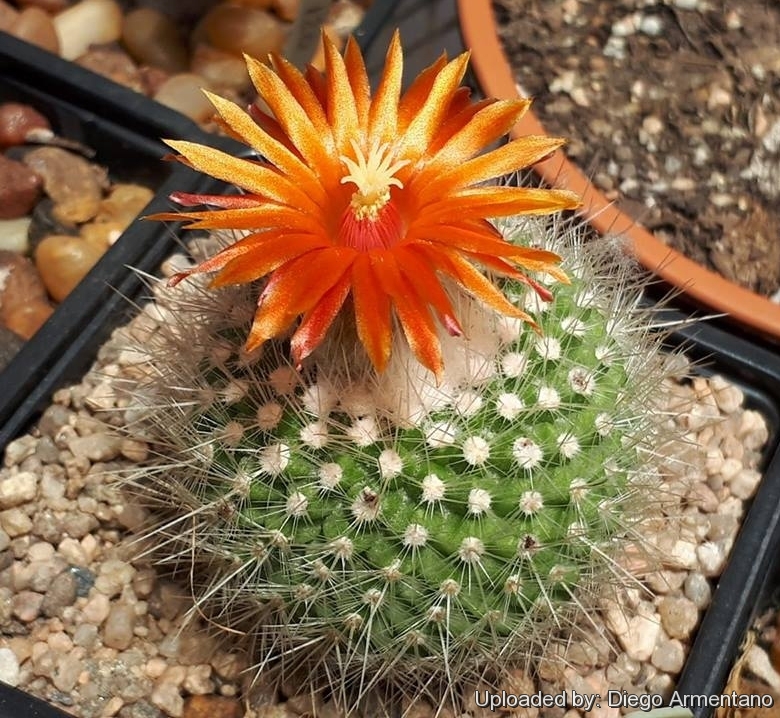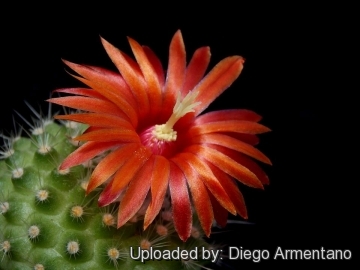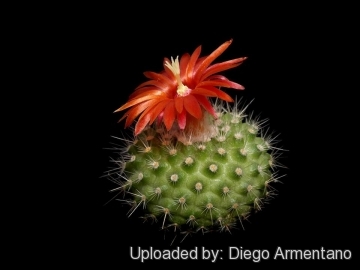




Your support is critical to our success.
Accepted Scientific Name: Parodia nivosa (Frič) Backeb.
Blätt. Kakteenf. 1934(12): [4] genus 68, sp. 5.

Origin and Habitat: Quebrada del Toro and Santa Rosa de Tastil in Salta province, Northern Argentina. Extent of occurrence less than 100 km2, with only one location known.
Altitude range: Parodia nivosaSN|28340]]SN|28340]] occurs at around 2,000 metres above sea level.
Habitat and Ecology: This cactus grows on rocky and silty soils on sheer rock cliff in the pre-puna habitat often together Cleistocactus hyalacanthusSN|9603]]SN|9603]]. This species is locally abundant but occurs only in a small area and the population is decreasing. The area where it occurs is under pressure from road construction. Also, the species is is intensively collected for ornamental purposes. These threats have caused population declines and will not cease in the near future. Hence, it is listed as Critically Endangered.
Synonyms:
- Parodia nivosa (Frič) Backeb.
- Echinocactus nivosus Frič
- Microspermia nivosa Frič
Parodia nivosa (Frič) Backeb.
Blätt. Kakteenf. 1934(12): [4] genus 68, sp. 5.
Synonymy: 7
- Parodia nivosa (Frič) Backeb.
- Echinocactus nivosus Frič
- Microspermia nivosa Frič
- Parodia nivosa var. faustiana (Backeb.) Käsinger
- Parodia faustiana Backeb.
- Parodia nivosa var. striatipetala Y.Itô
- Parodia uhligiana Backeb.
ENGLISH: Powder puff cactus, Snowball cactus, Golden star cactus, Ball cactus
Description: The powder puff cactus (Parodia nivosaSN|28340]]SN|28340]]) is a small ovoid, perennial cactus that has a solitary green stem with fine, stiff, white spines, each 1-2 cm long. It has a white, woolly crown from which bright red flowers appear in summer.
Stem: Spherical or eventually somewhat longer to 15 cm tall and 8 cm broad dull green, with dense white wool apically.
Ribs: Several, spiraling, forming distinct conical tubercles.
Areoles: White woolly when young.
Central spines: 4 white or one dark at base, to 2 cm long, all straight bristle-like.
Radial spines: About 18, white, 15-18 mm long, like the centrals but finer.
Flowers: Borne 1-7 together mostly 3 long, 2.5-3(-5) cm wide, red. Pericarpel and tube with wool and bristles throughout.
Fruits: small.
Seeds: Small to 0.8 x 0.5 mm smooth, brown, glossy.
Subspecies, varieties, forms and cultivars of plants belonging to the parodia nivosa group
 Parodia nivosa (Frič) Backeb.: has a solitary stem with fine, white spines, each 1-2 cm long. It has a white, woolly crown and bright red flowers. Distribution: Quebrada del Toro and Santa Rosa de Tastil, Salta, Argentina.
Parodia nivosa (Frič) Backeb.: has a solitary stem with fine, white spines, each 1-2 cm long. It has a white, woolly crown and bright red flowers. Distribution: Quebrada del Toro and Santa Rosa de Tastil, Salta, Argentina. Parodia nivosa var. faustiana (Backeb.) Käsinger: has four longer brown-black central spines up to 2.5 cm long, and flower orange with yellow throat (never red). Distribution: Quebrada del Toro and Santa Rosa de Tastil, Salta, Argentina.
Parodia nivosa var. faustiana (Backeb.) Käsinger: has four longer brown-black central spines up to 2.5 cm long, and flower orange with yellow throat (never red). Distribution: Quebrada del Toro and Santa Rosa de Tastil, Salta, Argentina.
Bibliography: Major references and further lectures
1) Edward Anderson “The Cactus family” Timber Press, Incorporated, 2001
2) David R Hunt; Nigel P Taylor; Graham Charles; International Cactaceae Systematics Group. "The New Cactus Lexicon" dh books, 2006
3) James Cullen, Sabina G. Knees, H. Suzanne Cubey “The European Garden Flora Flowering Plants: A Manual for the Identification of Plants Cultivated in Europe, Both Out-of-Doors and Under Glass” Cambridge University Press, 11/Aug/2011
4) Ortega-Baes, P. & Lowry, M. 2013. Parodia nivosa. The IUCN Red List of Threatened Species. Version 2014.2. <www.iucnredlist.org>. Downloaded on 09 August 2014.
5) Christopher Brickell “RHS Encyclopedia of Plants and Flowers” Dorling Kindersley Ltd, 01/Sep/2010
6) Sandy Baker “The Complete Guide to Keeping Your Houseplants Alive and Thriving: Everything You Need to Know Explained Simply” Atlantic Publishing Company, 2011
7) Hans Hecht “Cacti & Succulents” Sterling Publishing Company Incorporated, 1994
8) E Haustein “Der Kosmos Kakteenfuehrer (the Kosmos Cactus Guide)” Balogh Scientific Books, United States, 01/Dec/1998
9) Hiroshi Hirao “Colour encyclopaedia of cacti” Japan 1979 (Japanese language and script)
10) Zuloaga, F. O., O. Morrone, M. J. Belgrano, C. Marticorena & E. Marchesi. (eds.) 2008. “Argentina, Sur de Brasil, Chile, Paraguay y Uruguay” Monogr. Syst. Bot. Missouri Bot. Gard. 107(1): i–xcvi, 1–983; 107(2): i–xx, 985–2286; 107(3): i–xxi, 2287–3348.

Echinocactus nivosus (Parodia nivosa) Photo by: Diego Armentano

Echinocactus nivosus (Parodia nivosa) Photo by: Diego Armentano
Cultivation and Propagation: Parodia nivosaSN|28340]]SN|28340]] comes from mountainous areas, and in its natural habitat, warm rain falls and waters the plants, and in the winter, the it endures long, dry, and temperate zone conditions. It would be wise and fun to duplicate the plant's natural growing conditions and watch it mature into a healthy potplant. It has delightful flowers and the plant remains compact. It is easy to cultivate and recommended for beginners.
Growth rate: It is a slow growing but easily flowering species.
Soils: This species is easy to cultivate in a very open mineral mix with at least 50% sand or pumice grit.
Repotting: It is a small container size plants and prefers deep pots and good drainage to accommodate its roots, but it is rot prone, because of the sensitivity to excess of watering. It will occupy a small pot comfortably, and eventually remains a manageable sized house plant. It is better that it is repotted regularly. Repotting will increase the number of flowers produced. Repot yearly until it reaches about 5 cm in size, then every two or three years will suffice. Repotting is best done at the end of winter, but can be done at other times, too. Do not water for a couple of weeks after repotting, to reduce risk of root rot via broken roots. A layer of 'pea' gravel at the bottom of the pot improves drainage. A layer of decorative gravel as a top dressing helps prevent the caking of the potting mix, which decreases the rate of water absorption. It also keeps the perlite and pumice from blowing everywhere, and looks nice.
Watering:** It requires full sun or light shade and careful watering to keep the plant compact, and maintain strong and dense spines and allow the pot to dry out between waterings. Keep dry in winter at a minimum temperature of 0°C. It tends to rot if too wet. The plants can be placed outdoors in April, if protected from torrential rain and hail and direct sunlight. Water them thoroughly when placed out, and again in two weeks, and again in one week. After one month the plants are ready to be placed out in full sun and full rain for the summer. During dry spells the collection is watered once a week, during hot dry spells, twice a week.
Fertilization: Feed with a high potassium fertilizer in summer.
Hardiness:** It is reputedly resistant to frost if kept on the dry side prior to, and during, cold weather and requires a winter rest period (hardy to -7° C, or less for short periods). It grows in nature at high altitudes, and does not thrive well at high temperatures in cultivation. It will often go dormant in mid-summer, and resume growth again when the weather cools in late August. It is generally accepted that plants kept at too high a temperature, or watered too much during the winter rest period, will not bloom the following year.
Exposition: The plant tolerates extremely bright situations but enjoys filtered sunlight or afternoon shade, inside it needs bright light, and some direct sun. Tends to stay compact in strong light, which encourages flowering and heavy spine production, but is likely to suffer from sun scorch or stunted growth if over exposed to direct sunlight during the hottest part of the day in summer.
Uses: It is a fine plant for a rock garden or container. This variety is also likely to flower as a house plant, but results will depend on a variety of growing conditions.
Pests & diseases: All, especially the young, are susceptible to red spider mites.
Rot: It is especially prone to root rot, therefore, underpot in a smaller container filled with very porous compost. However rot it is only a minor problem with parodias if the plants are watered and “aired” correctly. If they are not, fungicides won't help all that much.
Propagation: To propagate, use only seed, but the process is difficult because it is slow. Seeds germinate in 7-14 days at 21-27° C in spring or summer remove gradually the glass cover as soon the plants will be well rooted (ca 1-2 weeks) and keep ventilated, no full sun for young plants! The seedlings should not be disturbed until they are well rooted, after which they can be planted separately in small pots.
| Your Actions | |
|---|---|
| Back to Echinocactus index | |
| Back to Cactaceae index | |
 |
Back to Cacti Encyclopedia index |
Privacy stantement - Terms and conditions - How to cite - About us - Feedback - Donate



